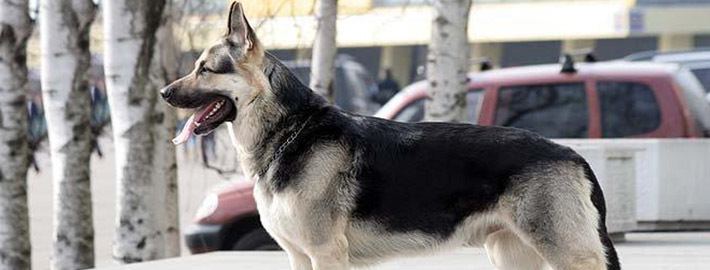Weight Male Female 30–50 kg (66–110 lb) Origin Russia Rank Breed | Male 35–60 kg (77–132 lb) Scientific name Canis lupus familiaris Higher classification Dog | |
 | ||
Height Males: 66–76 cm (26–30 in);
Females: 62–72 cm (24–28 in); Similar Moscow Watchdog, Central Asian Shepherd, Russkiy Toy, Caucasian Shepherd Dog, Black Russian Terrier | ||
The East-European Shepherd (VEO) (in Russian: Восточно-европейская овчарка (ВЕО)) —is a breed of dog that was developed in the 1930-1950s based on German Shepherd Dogs to create a larger cold-resistant breed for military use, police work and border guard duties in the Soviet Union. VEOs are also used as guide dogs for the blind and there are VEO therapy dogs. This breed is popular in Russia where it entered a public culture and acquired a legendary status as an extremely smart and loyal dog devoted to their owners. The breed is well known in other ex-Soviet Union republics. In the West, the East-European Shepherd is a rare breed that is not well known: information about the breed on online sources, in English, is limited and often incorrect or distorted.
Contents

Appearance

The East European Shepherd is larger than a German Shepherd: males are 66-76 centimetres (26–30 inches) at the withers and weight 35–50 kg, females are 62-72 centimetres (24.5–28 inches) and weight 30–50 kg. Along with a short coat of dense fur, they have strong (but not coarse) bones and well-developed muscles. Their coat is medium in length with a well-developed undercoat. The standard colors for these dogs include saddled (that can be saturated to give an almost black-and-tan or black-and-red appearance) with a black face mask and solid black. Well defined sable gray and sable red are acceptable colors.

The head of an East European Shepherd is of a 'wolfish' appearance, resting on a long neck in rather massive collar fur; it is proportional to the rest of the body. It is triangular and wedge-shaped with a slightly rounded forehead. The muzzle is equal in length to the skull, and the lower jaw is well developed. With large teeth in full complex and powerful jaw muscles, the dog is capable of a very strong hold and scissor-cutting bite . Their ears are medium in size and pricked. Their eyes are medium, oval, and dark, with close-fitting, well-colored eyelids.

Their backs are straight, strong, wide, and long. They are 10-17% longer than their height at withers. The loins are long and wide, well-muscled and slightly arched. Their croup is wide, long, and slightly sloping towards the tail. The tail is long, bears thick fir, erected in a form of a sword when the dog's excited. The chest is moderately wide, while the belly is reasonably tucked up. The chests are scimitar in form, reaching the hocks or slightly longer in some cases. The legs are strong and straight; feet are oval and compact. The dog's pace is of a trotter, rather than of a skid, sliding just above the ground so typical to other German Shepherds' cousins.
Temperament

The East European Shepherd is balanced, confident and intelligent. VEO is an attentive, active, self-assured dog that appears calm and quiet but constantly monitors situation and is ready to "turn on" on owner's command. The East European Shepherd has an active defensive reaction, distrusts strangers and can be aggressive when needed but under no circumstances it should be inclined to unmotivated aggression. VEOs excel as K9 and personal protection guard dogs or as companions.
East European Shepherds are working dogs and need a regular exercise. They were bred for their intelligence and they are curious and quick learners. Their ability to withstand extreme climates allows them to live outside, as well as inside, in a house or an apartment. They perform well as hunting dogs and can work as draught dogs in a group of the same.
Health
One of the main reason for development of VEO was to get rid of hip dysplasia and elbow dysplasia, a common disease in German Shepherds. Due to the large and open nature of their ears, East European Shepherds are not prone to ear infections. They live 10–14 years.
Origin
The breed was created in 1930-1950s as a working dog adapted for service in the Army and police as guard dogs and sniffer dogs in various climatic conditions. It was the result of crossbreeding German Shepherds with Russian dog breeds, such as the Caucasian Shepherd, the Central Asian Shepherd. Modern East-European Shepherd DNA bears both - traces of East Siberian Laika dogs and some lines of German Shepherds that had been inherited by the Russian Army from territory in Germany at the end of World War II.
The first standard which has formed the breed type of East European Shepherd was approved in 1964 by the Cynological Council of the Ministry of Agriculture of the USSR.
Recognition
The East European Shepherd is recognized by Russian Kynological Federation (RKF). In USA it is registered by the Dog Registry of America and the Continental Kennel Club.
